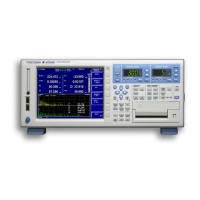1-26
IM WT3001E-51EN
Symbols and Determination of Motor Evaluation Measurement Functions
Measurement Functions
during Normal
Measurement
Method of Determination, Equation
Motor evaluation
Rotating
speed
Synchronous
speed
Slip
[%]
Motor
output
Pm
Torque
When the type of input signal from the revolution sensor is DC voltage (analog signal)
When the type of input signal from the revolution sensor is pulse count
Input voltage from the revolution sensor
•
Scaling factor
Number of input pulses from the revolution sensor per minute
Number of pulses per rotation
• Scaling factor
• Scaling factor
Motor’s number of poles
Scaling factor: Number of rotations per volt of input voltage
Scaling factor
• input voltage from the torque meter
•
100
Scaling factor: torque per volt of input voltage
Scaling factor: When the signal of the gear ratio or revolution sensor is a
converted signal, you can specify the gear ratio for the scaling factor to
determine the rotating speed before the gear change.
• The unit of synchronized speed is fixed to “min
–1
(or rpm).”
• Normally, the frequency measurement source is set to the voltage or current
that is supplied to the motor. The synchronized speed may not be
determined correctly if a different signal is specified.
When the unit of speed is “min
–1
(or rpm),” the unit of torque is “N·m,” and the
scaling factor is 1, the unit of motor output Pm is “W.”
SyncSp – Speed
SyncSp
• •
2 Torque Speed
60
When type of input signal from the torque meter is DC voltage (analog signal)
When the type of input signal from the torque meter is pulse count
Torque pulse coefficient and torque pulse offset: Calculated in this instrument
from the torque values [N·m] at two points corresponding to the upper and
lower limits of frequency.
Scaling factor: Normally, use the value of 1. When using a unit other than N·m,
set the conversion ratio of the unit.
(Torque pulse coefficient • pulse frequency + torque pulse offset) • scaling factor
120 Frequency of the frequency measurement source (Hz)
•
Set the efficiency equation or user-defined function to determine the motor efficiency and total efficiency.
1.10 Specifications of the Motor Evaluation Function

